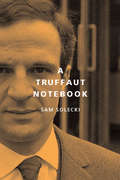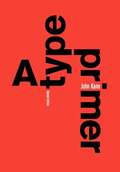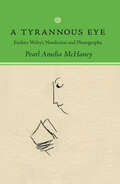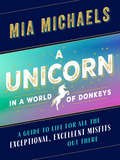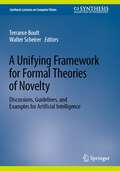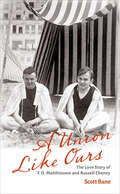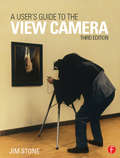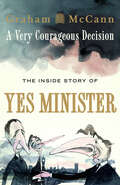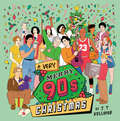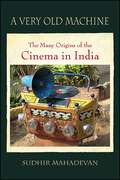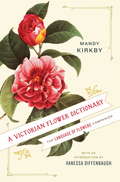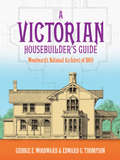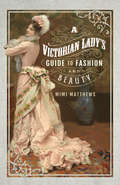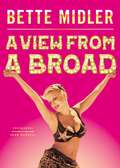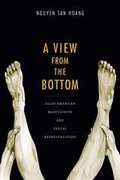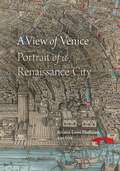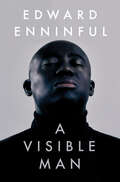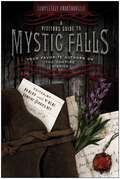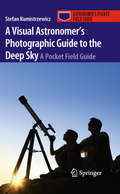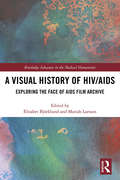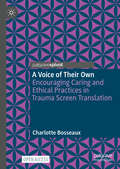- Table View
- List View
A Truffaut Notebook (McGill-Queen's Studies in Urban Governance #3)
by Sam SoleckiFrançois Truffaut (1932-1984) ranks among the greatest film directors and has had a worldwide impact on filmmaking as a screenwriter, producer, film critic, and founding member of the French New Wave. His most celebrated films include The 400 Blows, Shoot the Piano Player, Jules and Jim, Day for Night, and The Last Metro. A Truffaut Notebook is a lively and eclectic introduction to the life and work of this major cinematic figure. In entries as brief as a page, as well as in full-length essays, it examines topics such as Truffaut's mentors, the autobiographical nature of his films, his place in the film tradition, his film criticism, his reputation, his relationships with other directors, and the formal and thematic coherence of his body of work. Sam Solecki also argues for Truffaut's continuing appeal and relevance by examining his influence on filmmakers like Woody Allen, Noah Baumbach, Alexander Payne, Patrice Leconte, and Jean-Pierre Jeunet, and on writers such as Julian Barnes, Ann Beattie, and Salman Rushdie. Because the book returns regularly to the author's shifting responses to Truffaut's work over the last fifty years, it also offers an autobiographical meditation on his own lifelong fascination with film. Consisting of over eighty short entries and essays, as well as provocative lists, dreams, and quizzes, A Truffaut Notebook is an original and exciting text and a model of passionate engagement with cinema.
A Twisted Skein (Seaside Knitters Society #6)
by Sally GoldenbaumSet in the &“idyllic world&” (Publishers Weekly) of a small Massachusetts coastal community, rich in friendship and &“full of suspense and human warmth&” (The Washington Book Review), this skillfully written series combines intriguing mysteries with rich characters and emotional warmth. Like every coastal town, Sea Harbor needs tourists and their dollars. But there&’s something special about that time of year when summer people return to their normal lives, and the wide sandy beaches welcome back locals with their dogs and strollers. And this year, even as the season cools down, Izzy Perry&’s Sea Harbor Yarn Studio is heating up, thanks to an upcoming fashion benefit . . . The show will feature hand-knit garments, and enthusiastic knitters flock to the shop for supplies to create runway-worthy pieces. Yet Seaside Knitter Birdie is enjoying flocks of a different kind, thanks to a rekindled interest in birdwatching, a hobby she enjoyed with her late husband. Along with a small group of passionate birders, she often spends weekend mornings looking for warblers, or keeping watch for gannets and grebes. The group members themselves are almost as fascinating as the birds. It&’s a lovely, special time—until Birdie makes her way through a tangle of vines and stumbles upon a fellow birder&’s body. At first, it appears to be an accidental fall, but an autopsy soon reveals that the victim died before hitting a granite boulder. When police discover a clue linking the victim to one of the Seaside Knitters, the web of suspicion grows. Before the woods are ablaze in autumn glory and the knitters have cast off the final rows on their runway projects, they&’ll have to unravel secrets and ties strong enough to bind friends and neighbors together—and some that may press a killer to take another life.
A Type Primer
by John KaneDesigned for beginning design and typography students, this text assists students in understanding and demonstrating the basic principles of typography. Focused on intent and content, not affect or style, it makes informed distinctions between what is appropriate and what is merely show. Filled with examples, exercises, and background information―and designed itself to reflect good typographic design―it guides students systematically to the point where they can, not only understand but, demonstrate basic principles of typography, and thereby strengthen their own typographic instincts.
A Tyrannous Eye: Eudora Welty's Nonfiction and Photographs
by Pearl Amelia McHaneyA Tyrannous Eye: Eudora Welty’s Nonfiction and Photographs is the first book-length study of Eudora Welty’s full range of achievements in nonfiction and photography. A preeminent Welty scholar, Pearl Amelia McHaney offers clear-eyed and complex assessments of Welty’s journalism, book reviews, letters, essays, autobiography, and photographs. Each chapter focuses on one genre, filling in gaps left by previous books. With keen skills of observation, finely tuned senses, intellect, wit, awareness of audience, and modesty, Welty applied her genius in all that she did, holding a tough line on truth, breaking through “the veil of indifference to each other’s presence, each other’s wonder, each other’s plight.” McHaney’s study brings critical attention to the under-evaluated genres of Welty’s work and discusses the purposeful use of arguments, examples, and styles, demonstrating that Welty pursued her craft to a high standard across genres with a greater awareness of context than she admitted in her numerous interviews. Welty consistently dared new styles, new audiences, and new publishing venues in order to express her ideas to their fullest. It is “serious daring,” as she wrote in One Writer’s Beginnings, that makes for great writing. In “Place in Fiction,” Welty asks, “How can you go out on a limb if you do not know your own tree? No art ever came out of not risking your neck. And risk—experiment—is a considerable part of the joy of doing.”
A Ukrainian Christmas
by Yaroslav Hrytsak Nadiyka GerbishThe perfect gift this Christmas'History, stories, recipes and beautiful illustrations' - OLINA HERCULES'Christmas brings the indestructibility of hope in times of the greatest hopelessness. As long as we celebrate this holiday, we can neither be defeated nor destroyed. This is the message that Ukraine is trying to convey to the world. And this is what our book is about.'From Christmas music to gifts and food, as well as a look back through the country's rich and troubled history through the perspective of the festive season, this beautifully illustrated and powerful book introduces readers to Ukraine's unique Christmas traditions. In a country where East and West meet, this is a fascinating and unmissable guide to capturing the spirit of one of the most important times of year and a powerful reminder of the strength of holding on to your culture and beliefs, even as others try to take everything from you.'Sings of the independence of Ukraine yet ensures you feel the connecting hand of warmth, understanding, and friendship ... So profoundly meaningful and powerful, A Ukrainian Christmas ensures that you never lose sight of the true meaning of these festivities and how important they are in the lives of so many people' - LOVEREADING'Richly illustrated ... from Christmas music to gifts and food, it introduces readers to festive traditions followed in Ukraine' - Caroline Sanderson, THE BOOKSELLERThe Publisher is making a donation to the Disasters Emergency Committee Ukraine Humanitarian Appeal on publication of this book.
A Unicorn in a World of Donkeys: A Guide to Life for All the Exceptional, Excellent Misfits Out There
by Mia MichaelsAn empowerment manifesto for creatives, misfits, innovators, and disruptors from the star of So You Think You Can Dance and creator of Broadway's Finding NeverlandA Unicorn in a World of Donkeys offers a playbook for living a creative and authentic life. Using her own story as a launching spot, and creative quizzes, charts, and lists to engage the reader in an interactive journey, Mia Michaels explores the experience of the unicorn in a world of donkeys, a world where fitting in, pleasing others, following rules, and maintaining norms-no matter how messed up those norms are-is the only acceptable path. She acknowledges the struggles of the unicorn life-loneliness, ridicule, being misunderstood and undervalued-and goes on encourage readers to reframe the unicorn life the way she has, as essential to a life of brilliance.
A Unifying Framework for Formal Theories of Novelty: Discussions, Guidelines, and Examples for Artificial Intelligence (Synthesis Lectures on Computer Vision)
by Terrance Boult Walter ScheirerThis book presents the first unified formalization for defining novelty across the span of machine learning, symbolic-reasoning, and control and planning-based systems. Dealing with novelty, things not previously seen by a system, is a critical issue for building vision-systems and general intelligent systems. The book presents examples of using this framework to define and evaluate in multiple domains including image recognition image-based open world learning, hand-writing and author analysis, CartPole Control, Image Captioning, and Monopoly. Chapters are written by well-known contributors to this new and emerging field. In addition, examples are provided from multiple areas, such as machine-learning based control problems, symbolic reasoning, and multi-player games.
A Union Like Ours: The Love Story of F. O. Matthiessen and Russell Cheney
by Scott Bane“An example of how two men could—precariously and passionately—live together and love each other in the America of the 1930s and 1940s.” —Colm Tóibín, New York Times-bestselling author of The MagicianAfter a chance meeting aboard the ocean liner Paris in 1924, Harvard University scholar and activist F. O. Matthiessen and artist Russell Cheney fell in love, and remained inseparable until Cheney’s death in 1945. During the intervening years, the men traveled throughout Europe and the United States, achieving great professional success while contending with serious personal challenges, including addiction, chronic disease, and severe depression.Situating the couple’s private correspondence alongside other sources, Scott Bane tells the remarkable story of their relationship in the context of shifting social dynamics in the United States. From the vantage point of the present day, with marriage equality enacted into law, Bane provides a window into the realities faced by same-sex couples in the early twentieth century, as they maintained relationships in the face of overt discrimination and the absence of legal protections.“A nuanced exploration of a marriage, one characterized by great joy but also buffeted by tremendous conflict (societal, financial, and health-related).” —R. Tripp Evans, author of Grant Wood: A Life“A smart, sensitive study of a gay couple…extremely readable.” —Gay & Lesbian Review“An arresting account of how a same-sex relationship endured.” —Library Journal
A User's Guide to the View Camera: Third Edition
by Jim StoneThis reissued third edition of A User’s Guide to View Camera introduces photographers to large-format cameras, covering their use with both film and digital capture. Readers will learn the anatomy of cameras with a separately adjustable back or front, the proper techniques for using view cameras, and how to take care of large-format cameras—all through straightforward and practical instruction and abundant visual examples. This latest edition features: • Practical approaches to mastering lenses, shutters, accessories, and the ever-important maintenance of your view camera • Tips for both simple operation and advanced control of the camera, including film holders, bellows, and tripods, and film handling and development • A section on digital equipment, offering updates on the nearly 200-year-long history of the view camera
A Very Close Conspiracy: Vanessa Bell and Virginia Woolf
by Jane DunnThe lives of Virginia Woolf and her sister, Vanessa Bell, embodied opposites of human nature. The former was dedicated to the life of the mind and imagination, the latter to sensual experience. This book shows how the two sisters developed and enriched each other's lives.
A Very Courageous Decision: The Inside Story of Yes Minister
by Graham McCannA behind-the-scenes history of one of the most successful and admired British sitcoms of the 1980s.In 1977 the BBC commissioned a new satirical sitcom set in Whitehall. Production of its first series was stalled, however, by the death throes of Jim Callaghan’s Labour government and the ‘Winter of Discontent’; Auntie being unwilling to broadcast such an overtly political comedy until after the general election of 1979.That Yes Minister should have been delayed by the very events that helped bring Margaret Thatcher to power is, perhaps, fitting. Over three series from 1980—and two more as Yes, Prime Minister until 1988—the show mercilessly lampooned the vanity, self-interest and incompetence of our so-called public servants, making its hapless minister Jim Hacker and his scheming Permanent Secretary Sir Humphrey two of the most memorable characters British comedy has ever produced. The new prime minister professed it her favourite television programme—a ‘textbook’ on the State in inaction—and millions of British viewers agreed. In the years since Yes Minister has become a national treasure: Sir Humphrey’s slippery circumlocutions have entered the lexicon, regularly quoted by political commentators, and the series’ cynical vision of government seems as credible now as it did thirty years ago.Much of this success can be credited to its writers, Antony Jay and Jonathan Lynn, who drew on their contacts in Westminster to rework genuine political folly as situation comedy. Storylines that seemed absurd to the public were often rooted in actual events—so much so that they occasionally attracted the scrutiny of Whitehall mandarins. In A Very Courageous Decision acclaimed entertainment historian Graham McCann goes in search of the real political fiascos that inspired Yes Minister. Drawing on fresh interviews with cast, crew, politicians and admirers, he reveals how a subversive satire captured the mood of its time to become one of the most cherished sitcoms of Thatcher’s Britain.
A Very Merry 90s Christmas
by J. T. KelliherCelebrate this holiday season with all your favorite 90s stars, icons, and pop-culture moments!'Twas the night before Christmas when all through the house the only sound you could hear was the click of a mouse… This illustrated gift book is a perfect stocking stuffer for anyone who wants to relive the best decade of the twentieth century.
A Very Merry Dunder Mifflin Christmas: Celebrating the Holidays with The Office
by Christine KopaczewskiCelebrate the holidays the Dunder Mifflin way with this official, one-of-a-kind Christmas-spectacular handbook filled with recipes, tips, and pranks inspired by one of the most popular comedy series of all time. <P><P>Season's Greetings from Scranton, Pennsylvania, and your favorite group of Dunder Mifflin misfits. Over the course of seven iconic Christmas episodes, The Office delighted audiences everywhere with unconventional and seriously funny memories. Each December, ready to blow off a year's worth of pent-up boredom and frustration, the hyped-up holiday party was the ultimate escape from the team's monotonous paper-pushing gigs and the perfect recipe for chaos, love triangles, and prank wars to ensue -- and they did. <P><P>In A Very Merry Dunder Mifflin Christmas, relive your favorite festive moments -- like when Andy gifted Erin the twelve days of Christmas -- get tips on planning your own seasonal soiree like Angela and Phyllis, host the holidays like the Schrutes, prank your friends like Jim, Pam, and Dwight, and settle in for a round of Yankee Swap. This official licensed guide is an epic look back at all the ways Michael and his workmates at Dunder Mifflin made the most of their holiday seasons.
A Very Old Machine: The Many Origins of the Cinema in India (SUNY series, Horizons of Cinema)
by Sudhir MahadevanIn A Very Old Machine, Sudhir Mahadevan shows how Indian cinema's many origins in the technologies and practices of the nineteenth century continue to play a vital and broad function in its twenty-first-century present. He proposes that there has never been a singular cinema in India; rather, Indian cinema has been a multifaceted phenomenon that was (and is) understood, experienced, and present in everyday life in myriad ways. Employing methods of media archaeology, close textual analysis, archival research, and cultural theory, Mahadevan digs into the history of photography, print media, practices of piracy and showmanship, and contemporary everyday imaginations of the cinema to offer an understanding of how the cinema came to be such a dominant force of culture in India. The result is an open-ended and innovative account of Indian cinema's "many origins."
A Victorian Flower Dictionary
by Vanessa Diffenbaugh Mandy Kirkby"A flower is not a flower alone; a thousand thoughts invest it." Daffodils signal new beginnings, daisies innocence. Lilacs mean the first emotions of love, periwinkles tender recollection. Early Victorians used flowers as a way to express their feelings--love or grief, jealousy or devotion. Now, modern-day romantics are enjoying a resurgence of this bygone custom, and this book will share the historical, literary, and cultural significance of flowers with a whole new generation. With lavish illustrations, a dual dictionary of flora and meanings, and suggestions for creating expressive arrangements, this keepsake is the perfect compendium for everyone who has ever given or received a bouquet.From the Hardcover edition.
A Victorian Housebuilder's Guide: Woodward's National Architect of 1869 (Dover Architecture)
by Edward G. Thompson George E. WoodwardHere are detailed drawings, floor plans, elevations, specifications, and vintage cost estimates for twenty distinctive Victorian structures, ranging from a humble cottage to an ornate brick villa. They have been reproduced from a rare 1869 publication of Woodward's National Architect, a publication directed to builders, carpenters, and masons of the Victorian era.Each of these highly individual and appealing structures has been meticulously rendered in a landscaped perspective view along with front and side elevations, first- and second-floor plans, and close-up sections. With more than 580 black-and-white illustrations, the text provides directions for finishing trim, baseboards, and wainscoting; completing brick and plaster work; constructing chimneys, cesspools, and cisterns; and much more. With its wealth of authentic detail, A Victorian Housebuilder's Guide is a valuable resource for restorers, preservationists, builders, and anyone interested in the era's architecture.
A Victorian Lady's Guide to Fashion and Beauty
by Mimi Matthews&“Meticulously researched and beautifully illustrated . . . indispensable to anyone interested in the era.&” —Tasha Alexander, New York Times–bestselling author of the Lady Emily series What did a Victorian lady wear for a walk in the park? How did she style her hair for an evening at the theater? And what products might she have used to soothe a sunburn or treat an unsightly blemish? USA Today-bestselling author Mimi Matthews answers these questions and more as she takes readers on a decade-by-decade journey through Victorian fashion and beauty history. Women&’s clothing changed dramatically during the course of the Victorian era. Necklines rose, waistlines dropped, and Gothic severity gave way to flounces and frills. Sleeves ballooned up and skirts billowed out. The crinoline morphed into the bustle and steam-molded corsets cinched women&’s waists ever tighter. As fashion evolved, so too did trends in ladies&’ hair care and cosmetics. An era which began by prizing natural, barefaced beauty ended with women purchasing lip and cheek rouge, false hairpieces and pomades, and fashionable perfumes. Using research from nineteenth-century beauty books, fashion magazines, and lady&’s journals, the author of the Parish Orphans of Devon series brings Victorian fashion into modern day focus—and offers a glimpse of the social issues that influenced women&’s clothing and the outrage that was a frequent response to those bold females who used fashion and beauty to assert their individuality and independence. &“An elegant resource that I will be reaching for again and again.&”—Deanna Raybourn, New York Times-bestselling author of the Veronica Speedwell novels
A View from A Broad
by Bette MidlerBette Midler, also known as Divine Miss M--the indomitable and incomparable singer, actor, and musical theater extraordinaire, with a career spanning almost half a century--revisits her classic memoir, now with a new introduction.This book was a kind of last hurrah. When I read it, I hear a disarmingly younger, sweeter voice...I am not sure that this little confection captures a whole time, but I think it's an accurate picture of the spirit and tone of what I was doing in those days...I hope it holds up, and that you find your best younger self in it as I do... With her brassy voice and bold performances making the world finally pay attention, this ambitious Jewish girl from Hawaii, needs no introduction. Grammy award-winning singer, Academy Award-nominee, Broadway star of her critically acclaimed one-woman show, and beloved actress in The Rose, Beaches, and Down and Out in Beverly Hills--Bette Midler is a household name whose career and fans span generations. In A View from A Broad, Bette relives her career through memories of endless rehearsals, her fear of flying, crazy schedules, and wisdom she learned from Thai Gondoliers with her trademark razor-blade wit that her fans have grown to know, love, and expect. Filled with photographs, a new introduction, and heartwarming stories that highlight only a portion of a brilliant career, A View from a Broad is the perfect gift for anyone who loves music, theater, or just plain fun--and will be cherished by the fans of Divine Miss M for years to come.
A View from the Bottom: Asian American Masculinity and Sexual Representation
by Tan Hoang NguyenA View from the Bottom offers a major critical reassessment of male effeminacy and its racialization in visual culture. Examining portrayals of Asian and Asian American men in Hollywood cinema, European art film, gay pornography, and experimental documentary, Nguyen Tan Hoang explores the cultural meanings that accrue to sexual positions. He shows how cultural fantasies around the position of the sexual "bottom" overdetermine and refract the meanings of race, gender, sexuality, and nationality in American culture in ways that both enable and constrain Asian masculinity. Challenging the association of bottoming with passivity and abjection, Nguyen suggests ways of thinking about the bottom position that afford agency and pleasure. A more capacious conception of bottomhood--as a sexual position, a social alliance, an affective bond, and an aesthetic form--has the potential to destabilize sexual, gender, and racial norms, suggesting an ethical mode of relation organized not around dominance and mastery but around the risk of vulnerability and shame. Thus reconceived, bottomhood as a critical category creates new possibilities for arousal, receptiveness, and recognition, and offers a new framework for analyzing sexual representations in cinema as well as understanding their relation to oppositional political projects.
A View of Venice: Portrait of a Renaissance City
by Kristin Love Huffman, EditorJacopo de’ Barbari’s View of Venice, a woodcut first printed in the year 1500, presents a bird’s-eye portrait of Venice at its peak as an international hub of trade, art, and culture. An artistic and cartographic masterpiece of the Renaissance, the View depicts Venice as a vibrant, waterborne city interconnected by canals and bridges and filled with ornate buildings, elaborate gardens, and seafaring vessels. The contributors to A View of Venice: Portrait of a Renaissance City draw on a high-resolution digital scan of the over nine-foot-wide composite print to examine the complexities of this extraordinary woodcut and portrayal of early modern Venetian life. The essays show how the View constitutes an advanced material artifact of artistic, humanist, and scientific culture. They also outline the ways the print reveals information about the city’s economic and military power, religious and social infrastructures, and cosmopolitan residents. Featuring methodological advancements in the digital humanities, A View of Venice highlights the reality and myths of a topographically unique, mystical city and its place in the world.Contributors. Karen-edis Barzman, Andrea Bellieni, Patricia Fortini Brown, Valeria Cafà, Stanley Chojnacki, Tracy E. Cooper, Giada Damen, Julia A. DeLancey, Piero Falchetta, Ludovica Galeazzo, Maartje van Gelder, Jonathan Glixon, Richard Goy, Anna Christine Swartwood House, Kristin Love Huffman, Holly Hurlburt, Claire Judde de Larivière, Blake de Maria, Martina Massaro, Cosimo Monteleone, Monique O’Connell, Mary Pardo, Giorgio Tagliaferro, Saundra Weddle, Bronwen Wilson, Rangsook Yoon
A Visible Man: A Memoir
by Edward EnninfulFrom one of our culture's most important changemakers, a memoir of breaking barriers.When Edward Enninful became the first Black editor-in-chief of British Vogue, few in the world of fashion wanted to confront how it failed to represent the world we live in. But Edward, a champion of inclusion throughout his life, rapidly changed that. Now, whether it&’s putting first responders, octogenarians or civil rights activists on the cover of Vogue, or championing designers and photographers of colour, Edward Enninful has cemented his status as one of his world&’s most important changemakers. A Visible Man traces an astonishing journey into one of the world&’s most exclusive industries. Edward candidly shares how as a Black, gay, working-class refugee, he found in fashion not only a home, but the freedom to share with people the world as he saw it. Written with style, grace, and heart, A Visible Man shines a spotlight on the career of one of the greatest creative minds of our times. It is the story of a visionary who changed not only an industry, but how we understand beauty.
A Visitor's Guide to Mystic Falls: Your Favorite Authors on The Vampire Diaries
by Red VeeThe Vampire Diaries, the television series based on the iconic books by L.J. Smith, has already managed to captivate millions of viewers with its unique mix of immortal romance and very human drama. In A Visitor's Guide to Mystic Falls, YA authors—led by Red and Vee of premier Vampire Diaries resource Vampire-Diaries.net—take a closer look at Mystic Falls: its residents (both alive and undead) and its rich, inescapable history. Claudia Gray delves into the events of 1864 and how they've shaped not just Mystic Falls but the success of the show itself Sarah Rees Brennan tells us what it takes for a girl to hold her own against a vampire boyfriend (or two), placing Elena squarely between fellow vampire-daters Buffy and Bella Jennifer Lynn Barnes takes Mystic Falls to task for poor treatment of Caroline Forbes Jon Skovron examines the male-female vampire dynamic, in history and in The Vampire Diaries Plus a guide to the book series for tv fans looking to visit The Vampire Diaries' literary inspiration, and more Whether you're a new visitor or a long-time fan, you won't want to continue your tour of Mystic Falls without it.
A Visual Astronomer's Photographic Guide to the Deep Sky: A Pocket Field Guide (Astronomer's Pocket Field Guide)
by Stefan RumistrzewiczThis book is meant for observers who see a deep-sky object - either by star-hopping or by using a Go-To telescope - but do not observe it in detail because they don't know what to look for. It provides photographic images of all the objects discussed... not just images, but images that look exactly like the visual view through the eyepiece of telescopes of various apertures. Visually, deep-sky objects almost always look quite unlike the usual CCD images published in astronomical guides. The human eye doesn't see color at such low light levels, and the contrast of extended objects (such as nebulae and galaxies) is completely different. The author lives in a less-than ideal location for visual observing, with the city of London only about twenty miles to the south. He uses this to advantage, and amateur astronomers will find this book invaluable because it shows them what they will actually see from a typical suburban location, not a rare view under perfect skies.
A Visual History of HIV/AIDS: Exploring The Face of AIDS film archive (Routledge Advances in the Medical Humanities)
by Elisabet Björklund Mariah LarssonThe Face of AIDS film archive at Karolinska Institutet, Sweden, consists of more than 700 hours of unedited and edited footage, shot over a period of more than thirty years and all over the world by filmmaker and journalist Staffan Hildebrand. The material documents the HIV/AIDS pandemic and includes scenes from conferences and rallies, and interviews with activists, physicians, people with the infection, and researchers. It represents a global historical development from the early years of the AIDS crisis to a situation in which it is possible to live a normal life with the HIV virus. This volume brings together a range of academic perspectives – from media and film studies, medical history, gender studies, history, and cultural studies – to bear on the archive, shedding light on memories, discourses, trauma, and activism. Using a medical humanities framework, the editors explore the influence of historical representations of HIV/AIDS and stigma in a world where antiretroviral treatment has fundamentally altered the conditions under which many people diagnosed with HIV live. Organized into four sections, this book begins by introducing the archive and its role, setting it in a global context. The first part looks at methodological, legal and ethical issues around archiving memories of the present which are then used to construct histories of the past; something that can be particularly controversial when dealing with a socially stigmatized epidemic such as HIV/AIDS. The second section is devoted to analyses of particular films from the archive, looking at the portrayal of people living with HIV/AIDS, the narrative of HIV as a chronic illness and the contemporary context of particular films. The third section looks at how stigma and trauma are negotiated in the material in the Face of AIDS film archive, discussing ideas about suffering and culpability. The final section contributes perspectives on and by the filmmaker as activist and auteur. This interdisciplinary collection is placed at the intersection of medical humanities, sexuality studies and film and media studies, continuing a tradition of studies on the cultural and social understandings of HIV/AIDS.
A Voice of Their Own: Encouraging Caring and Ethical Practices in Trauma Screen Translation
by Charlotte BosseauxThis open access book explores which audiovisual translation methods or techniques are the most ethical when translating personal narratives dealing with trauma and emotions, and provides good practice guidelines for different stakeholders (audiovisual translators, Language Service Providers, charities, survivors and filmmakers) to ensure that the voices of those who have suffered from trauma and Gender-Based Violence are ethically conveyed on-screen. It also shows how subtitlers cope with the translation of challenging sensitive material. The work described in this book is based on Prof Bosseaux&’s Ethical Translation project and is underpinned by a practical component: a multilingual documentary featuring women who have gone through traumatic events and whose first language is not English. Above all, the research emphasises the importance of filming and translating ethically with a focus on making sure survivors and audiovisual translators&’ voices are fully heard through respectful translation. This book showcases the theories and methods used and developed throughout the Ethical Translation project and the results of the research conducted, ultimately demonstrating the importance of carrying out practice-based research and encouraging collaboration between academics, practitioners and stakeholders to produce research that can be of use to, and be applied by, these groups.
